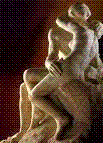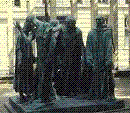|
|
Born poor, rejected from art academies, he did experience some fame and recognition before dying. He was generally out of sink with the prevailing trends of his time (neo-classical revivals, celebratory and monumental). He often travelled to London to meet the Pre-Raphaelites and greatly appreciated the art of William Blake. Like him, he brought Dante's genius to the attention of Romantic sensibilities.
What he thought of The kiss:

What he thought of The thinker:


Sculpture: He is said to have infused the realism of his times with expressionism. He deliberately left unfinished parts and fragments on his sculptures. Great admirer of Michelangelo, he tried to capture bodily movement - which he defined as �the transfer/translation from one attitude to another' - in sculpture � which he defined as �the art of the hole and the mass'.
Drawings: Renowned for his technique of �continuous drawing', it is said to have inspired Schiele's style. Rodin would not let his eyes leave the model as he drew. He said he adopted this technique �to test to what extent my hands already feel what my eyes see.� This gave a sense of immediacy to his drawings.
Ambroise Vollard reports of a wild "slaughter", in which Rodin chopped off the head and limbs of a series of enlargements with a big sword. To his shocked guests, he explained that during the enlargement process, the right proportions of the subject had gone astray; the single parts, however, were of perfect shape. He leaves behind many unfinished works.
He was clearly attracted to womanhood from all perspectives. In large series of drawings, Rodin circles around the centre of the female body, the �eternal tunnel�, or The Origin of the World � the title of Gustave Courbet´s 1866 painting, that still provokes visitors in the Musée d´Orsay. Biographical note: his long term girlfriend, sculptress and artist Camille Claudel, ended up in a mental hospital and was kept there for 30 years. She is supposedly the muse of The Kiss, but Rodin married the mother of his child instead.
Rainer Maria Rilke worked for Rodin's secretary for several years. He said of the Burghers of Calais: �[Rodin] felt immediately that there was a moment in this story when something portentous took place, something independent of time and place, something simple, something great. He concentrated all his attention upon the moment of the departure. He saw how the men started on their way, he felt how through each one of them pulsated once more his entire past life, he realized that each one stood there prepared to give that life for the sake of the old city. Six men rose before him, of whom no two were alike. Rilke also wrote Rodin's biography, and this: Completeness is conveyed in the armless statues of Rodin: Nothing necessary is lacking. He describes Rodin as �a worker whose only desire was to penetrate with all his forces into the humble and difficult meaning of his tools�.
Rodin has a modest attitude toward his art. When he finished his Balzac , which remains the incontestable point of departure for modern sculpture, he declared, "It is now that I would like to begin work. Constantin Brancusi